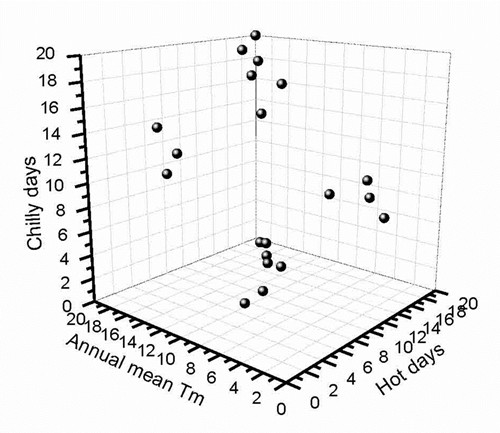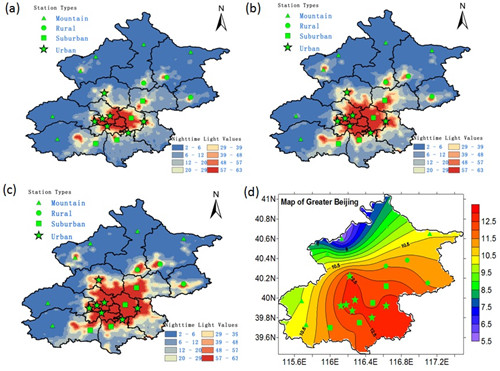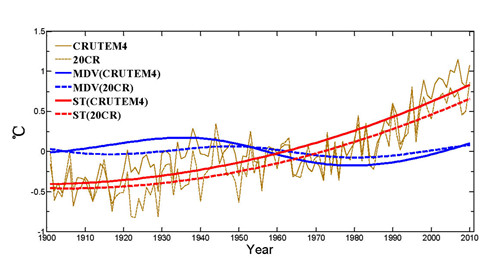Urbanization-related Warming in Local Temperature Records
Date:2016-03-22
Urbanization involves artificial changes to both the land surface and energy consumption, and hence affects the surface energy budget and land–atmosphere interaction, resulting in a changing “urban heat island” effect. Therefore, urbanization usually induces a warming trend in the observed surface air temperature series; and because this is similar to the influence of the increasing concentration of atmospheric greenhouse gases, the effect of urbanization has become a matter of considerable concern in the field of climate change detection and attribution. In a paper published in Atmospheric and Oceanic Science Letters, Dr. WANG Jun and Prof. YAN Zhongwei (Institute of Atmospheric Physics, Chinese Academy of Sciences) review current estimates of the urbanization-related warming in the observed land surface air temperature series in China (Wang and Yan, 2016).
Owing to dramatic urban development since the 1980s, the station temperature records in China appear to have been more seriously influenced by this factor than in other regions elsewhere in the world. Many previous studies have suggested that the local warming due to urbanization could have been about 0.1°C/10 yr or even larger. However, based on recently developed homogenized temperature records and improved methods, the estimated urban warming is much smaller.
A simple idea to estimate the urban warming effect is to compare the temperature trend at urban stations with that at nearby rural stations. Socioeconomic indices, satellite data, and statistical analysis methods are commonly used to identify different types of stations, but each has its limitations. By applying an objective cluster analysis, the authors classified stations into urban and non-urban types (Figures 1 and 2). Then, based on a homogenized dataset, they estimated that the urban warming at the most influenced urban station of Beijing should be about 20%, much smaller than previous estimates for the same station (from 40% to even 80%).

Figure 1. Three-dimensional scatter plot for the results of cluster analyses for three temperature indices (annual mean temperature, number of chilly days, and number of hot days). Source: Wang et al. (2013a)

Figure 2. Geographic patterns of nighttime light intensity in the Greater Beijing region in (a) 1992, (b) 2000, and (c) 2008. (d) Locations of 20 meteorological stations and the geographic distribution of annual mean temperature during 1978–2008 (units: °C). Green stars, squares, solid dots, and triangles represent urban, suburban, rural, and mountain stations, respectively. Source: Wang et al. (2013a).
Another avenue of research involves the use of reanalysis data. The "observation-minus-reanalysis (OMR)" method was proposed to estimate the impact of land-cover change (e.g., urbanization), based on the fact that the reanalysis data represent large-scale climate change but do not fully take into account the local effect of urban land-use. However, the authors found that the systematic bias in the multi-decadal variability (MDV) of the reanalysis data could modulate the magnitude of OMR trends considerably during different periods (Figure 3).

Figure 3. Averaged Northern Hemisphere land surface air temperature series (brown lines), secular trend (ST: non-linear secular trend; red lines) and MDV (blue lines), based on CRUTEM4 (solid lines) and 20CR (dashed lines). Source: Wang et al. (2013b).
Besides the uncertainties inherent in the methods adopted in this field, and those due to the inhomogeneity of temperature records, the authors also point out that further understanding and quantification of urbanization-related climate effects should rely upon the application of high-resolution regional climate modeling along with emerging high-resolution land-use information in the region, as demonstrated in recently published works.
References
Wang, J., Z. W. Yan, Z. Li, W. D. Liu, and Y. C. Wang, 2013a: Impact of urbanization on changes in temperature extremes in Beijing during 1978-2008, Science Bulletin, 58, 4679-4686. http://link.springer.com/article/10.1007/s11434-013-5976-y
Wang, J., Z. W. Yan, P. D. Jones, and J. J. Xia, 2013b: On “Observation minus Reanalysis” method: A view from multidecadal variability, Journal of Geophysical Research-Atmosphere, 118, 1-9. http://onlinelibrary.wiley.com/doi/10.1002/jgrd.50574/full
Wang, J., and Z.-W. Yan. 2016. "Urbanization-related warming in local temperature records: A review." Atmospheric and Oceanic Science Letters 9(2): 129–138. http://www.tandfonline.com/doi/abs/10.1080/16742834.2016.1141658
Contact: Prof. YAN Zhongwei, yzw@tea.ac.cn
